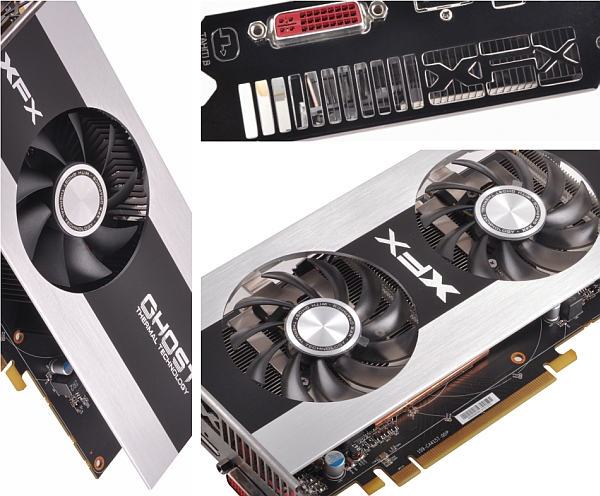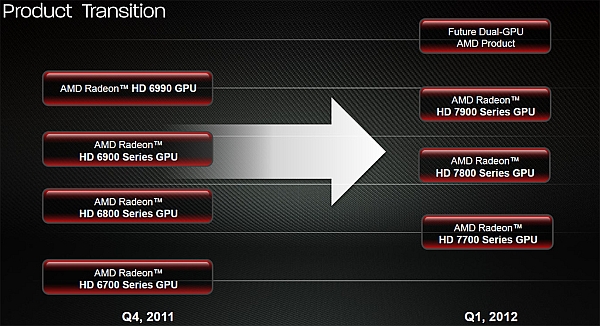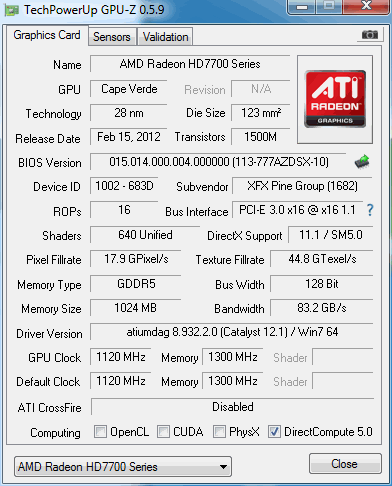Index


Review: 1120MHz GPU out of the box
Today AMD is launching Radeon HD 7700 series, i.e. its new mid-range graphics cards - the HD 7770 and HD 7750. HD 7700 series, just like the HD 7900 and HD 7800 series, uses the new GCN architecture and TSMC's 28nm technology.
Of course, XFX is locked and loaded and this time around with no less than five different HD 7770s:
HD 7770 Core Edition,
HD 7770 Double Dissipation Edition,
HD 7770 Black Edition,
HD 7770 Black Edition featuring Double Dissipation,
HD 7770 Black Super OC Edition featuring Double Dissipation
Since today is HD 7750's day as well, XFX has another four cards in store:
HD 7750 Core Edition,
HD 7750 Double Dissipation Edition,
HD 7750 Black Edition,
HD 7750 Black Edition featuring Double Dissipation.

The new series should replace the preceding HD 6700 series. As usual, the HD 7700 series should bring improved performance and improved consumption.
The GPU used on HD 7700s is known as Cape Verde. This GPU uses GCN architecture, which is more efficient than VLIW5. Although Cape Verde has less Radeon cores than the HD 6670 and HD 6750, it still manages to score better. This is partially down to the high operating clocks of the HD 7700 cards. Namely, reference clocks for the HD 7770's GPU stand at 1GHz whereas the HD 7750's ticker runs at 800MHz. Note that the HD 6770's GPU runs at 850MHz (800 cores) while the HD 6750 ticks at 725MHz (720 cores).
According to AMD’s product transition sheet (picture below), the new HD 7700 card series will be faster than any graphics card from the HD 6700 series, but we see that the real battle will involve its HD 6850.
Our today's guest is XFX's Black Super OC Double Dissipation Radeon 7770 1120M 1GB D5 2Xm DP HDMI DVI. The name suggests that the card runs at 1120MHz, which gives it a nice platform to fight with the HD 6850. The card is also notable for using the Double Dissipation cooler, which ensures that the card remains cool at extremely high clocks.

The HD 7700 series belongs to Southern Island family, which is the first GPU family with GPUs made in 28 nanometer silicon fabrication processes, first to use PCI Express 3.0 x16 bus, and first with DirectX 11.1 support.
Cards from the HD 7700 series run on Cape Verde GPU, which is related to the HD 7900 series' GPU called Tahiti. However, Cape Verde is a smaller chip will less capabilities. Compared to the Tahiti's 1792 cores, Cape Verde XT (HD 7770) has only 640 while the PRO version of the chip (HD 7750) comes with 512 cores.
HD 7770 cards have 40 texture units and 16 ROPs. The 1GB of GDDR5 memory runs on 128-bit memory interface. HD 7750 cards have 32 texture units but the number of ROPs and the memory interface are identical to the HD 7770. According to the specs, HD 7770 cards have a TDP of 80W while HD 7750's TDP is 55w.
XFX’s Radeon HD 7770 Black Super OC ticks at 1120MHz for the GPU, making for a nice, 120MHz overclock over reference 1000MHz.




